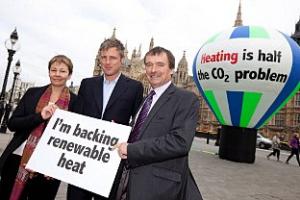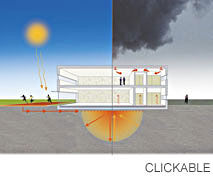Clean Energy Cashback
The Government's incentives to transition heat systems to heat pumps are now concentrated on the Boiler Upgrade Scheme for houses and the PSDS for public sector buildings.
Feed-In Tariffs – FiTs
The "Feed-In Tariffs" were inspired by Germany which had been providing genuine Feed-In Tariffs for some years: consumers in Germany (and Spain and elsewhere) are paid by the electricity supply companies for electricity fed back to the grid. The "Feed-In Tariffs" introduced in the UK are more correctly described as "Clean Energy Cashback" for consumers receive a cashback subsidy administered by Ofgem for the metered on site electricity generated – whether, or not it is fed back to the Grid. Where surplus electricity is generated and fed back to the grid the consumer also receives a further 3.1 pence per kW hour as a genuine "Feed-In Tariff". The amount of cashback received depends on the mechanism by which it is generated and the scale on which it is generated according to the tariff table for Feed-In Tariffs.

Renewable Heat Incentive – RHI
The UK government is claiming a 'first" for the Renewable Heat Incentive: this is also a clean energy cashback scheme which will be received by those who generate on-site renewable heat for their own consumption. It is not possible for consumers to provide surplus heat back to any national heat grid, and the government does not want to pay for any excess heat generated, so Ofgem will only provide the subsidy up to the level of metered heat used by your building. The amount of cashback received for RHI depends on the mechanism by which it is generated and the scale on which it is generated according to the tariff table for Renewable Heat Incentive.
The tariffs for ground source heat pumps are to double for applications made after 21 January 2013.
The Renewable Heat Incentive has received strong backing from MPs from all political parties, including Caroline Lucas, Zac Goldsmith and Alan Whitehead.
What is the logic for the tariff tables?
Ofgem will pay the clean energy cashback from just 1.5 p/kWh up to a generous 36.2 p/KWh. The tables have been calculated not on the amount of CO2 saved per kWh, but on a calculation to provide an incentive to owners to install renewable energy in such a way as to provide a financial return on the initial sum invested. Therefore the less economic forms of generation are deemed to need a larger subsidy! The intention is to encourage installation of renewable electricity and renewable heat across a wide range of technologies.
For the Renewable Heat technologies included, the energy ultimately comes from the sun. The sun provides planet earth with more energy each hour than human civilization uses over a whole year. The challenge is how to make use of this vast supply of incoming radiation to provide solar space heating and hot water.
Comment on the Clean Energy Cashback
Erich Scherer of DECC claimed that drawing up the original consultation document was a lot more difficult than first thought. He said that more technologies and scales could be covered by the RHI, but that there is not currently enough data to allow DECC to calculate tariff levels for each one. "We are very excited about the consultation, but we found that in designing the RHI it wasn't easy. There are issues that need to be solved and DECC need solutions to be put forward by the renewables industry".
"It is a big challenge to get renewable heat to where it needs to be and we wanted to design the scheme so that it works for as many target groups and as many technologies as possible. We are aware that there are other technologies that could be supported too, but at this stage we haven't got enough data to enable us to calculate a tariff for each one."
An investment in renewable energy usually means payment of a higher capital cost to achieve lower annual running costs (and also a lower carbon emission for the benefit for the community at large). The RHI reduces the annual running cost of Interseasonal Heat Transfer to zero and contributes to the capital cost of investment in IHT. RHI allows owners to reduce the payback period from their investment to a few years.
Owners of IHT installations benefit from the clean energy cashback for using ground source heat pumps and the clean energy cashback for using Solar Thermal when IHT is used to provide domestic hot water.
The introduction of the RHI offers a financial reward for lower carbon emissions over the deemed life of the renewable heat technology installed. The tariffs for the Renewable Heat Incentive have been calculated to offer a rate of return of 12% on the initial investment across the tariff bands.
The introduction of the RHI coincides with a time of increasing wealth and demand for fossil fuels from an increasing world population: many pundits expect the price of oil and gas to increase much more sharply than general inflation over the next three years.
While there are a number of renewable energy options to be considered, ICAX believes the most practical, affordable and sustainable answer to generating Renewable Heat is to use Interseasonal Heat Transfer.
The RHI provides a positive step change in the business case for delivering on-site renewable heat, not only to reduce energy bills and carbon emissions, but also to deliver an energy related cash flow into your building.
See also: Banking on IHT The Merton Rule Ground Source Energy Costs & benefits of IHT

